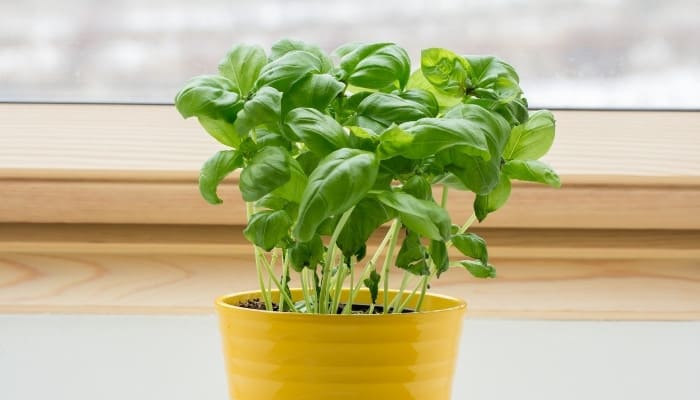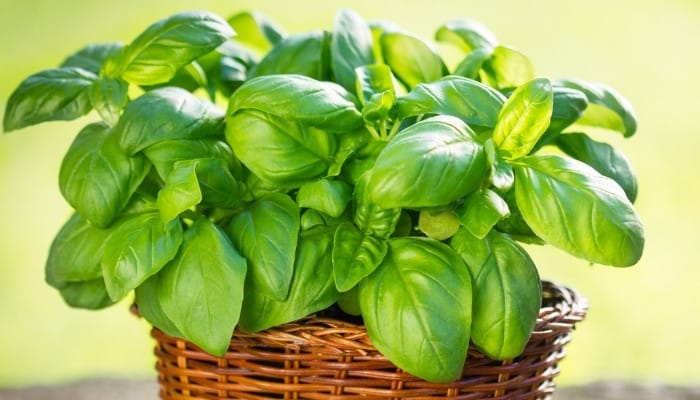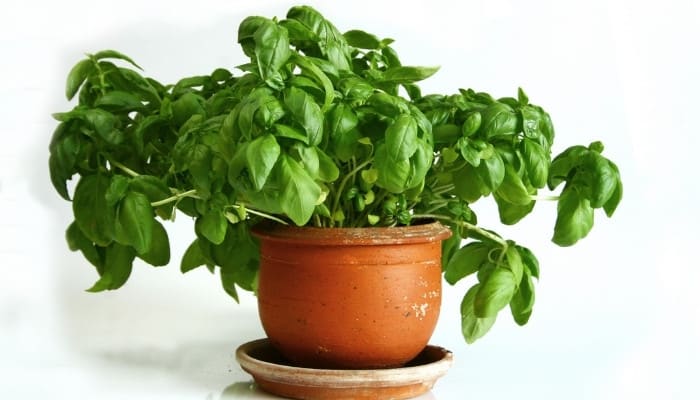Basil, known for its versatility as a salad ingredient, pizza topping, and tea flavoring, is a highly sought-after fast-growing plant that can bring joy to any gardener.
However, this herb can easily run into health issues if you take your eye off the ball, and a common headache is when those large, glossy leaves start to curl.
Why are my basil leaves curling? Basil leaves curl in response to environmental stressors such as imbalanced watering, poor soil, improper lighting, and temperature fluctuations which shock and distort its growth. Fungal disease and sap-sucking pests like thrips and aphids also weaken and warp the foliage structure.
There are quite a few offenders at the root of basil leaf curling that can make care overwhelming, but once you know what to spot and have the plant’s basic needs covered, things get easier (we promise!).
Let’s dive into 8 causes behind curling leaves and their solutions. We’ll also share pro tips and explain other common basil leaf issues.
Reasons for Curling Leaves in Basil Plants
Improper conditions and sneaky bug infestations can weaken and wither your basil leaves if left unchecked, which can lead to an inedible (or dying) plant if neglect allows disease to take hold.
1. Watering Issues
As a soft-stemmed plant, basil has low turgor pressure (the force exerted by water in plant cells to give them a sturdy structure), so without enough water to support the tissue, basil leaves wrinkle and curl.
On the flip side, overwatering causes lower leaf curling as a result of waterlogged soil choking and eventually rotting the roots.
Solution
Monitor the soil daily, ensuring moist – not soggy – conditions.
Provide garden-planted basil with one deep watering of 1 inch a week, and water indoor/potted basil every 1-3 days, watering twice daily in very hot summers.
For extra guidance, read through our Complete Basil Watering Guide.
2. Lighting Issues
Outdoors, basil prefers 6-8 hours of daily sunlight – exposure to anything outside this sweet spot causes the leaf edges and tips to curl and droop or scorch.
With indoor-grown basil, you’ll spot similar symptoms, accompanied by smaller leaves and leggy stems.
Solution
Observe the sun patterns in your garden and plant (or place potted) basil accordingly, ensuring it receives partial shade.
Grow indoor basil directly in a sunny south-facing windowsill, supplementing with two hours under grow lights (I recommend these free-standing, programmable lights).
Also, give indoor plants a quarter-turn every three days to promote balanced growth.
3. Temperature Issues
Basil is native to India, so daytime temperatures outside of its ideal range of 72-82°F can cause not only curled leaf edges but plant death due to scorch or frost damage.
According to studies, ensuring night temperatures remain between 64 and 71°F is equally important, not only in preventing leaf curl but in helping the plant preserve maximum flavor and aroma.
Solution
Prune back damaged leaves, and cover plant with an upturned crate/box to protect against late spring frosts, or consider placing a heat pad (a seedling heat mat is idea) under indoor basil to regulate temperatures.
Remember to increase watering frequency to prevent dehydration during heatwaves.
4. Pests
Leaf undersides can be home to green aphids that suck the sap, causing leaves to pucker and curl inwards.
What’s more, aphid activity often attracts destructive ants which are lured in by the sticky honeydew substance left behind.
Check routinely for aphid eggs (tiny spherical white/brown/yellow bean shapes on leaf undersides and the soil).
Solution
Directly spray pests and both leaf sides with neem oil (I use and recommend this one) or a solution of water mixed with 8 drops of dish soap. This should deter primary basil pests and their egg laying.
As for the ant problem? Keep strong-smelling herbs nearby.
Devoted herb grower Andrea Ballanti from Your Indoor Herbs and Garden explains, “pungent aromas like mint and rosemary repels ants by masking the scent trail they release to trace food (basil leaves).”
5. Disease
Poor growing conditions, such as soggy soil due to overwatering, can cause root rot, which affects how well water is transported to the plant, leading to starved, curling foliage.
A combination of heavy watering and warmer weather can also bring about the deadly fungus Fusarium wilt which blocks the plant’s water-conducting cells.
Solution
Careful watering is vital to prevent Fusarium wilt from settling in the soil. Cleaning your garden equipment and maintaining good pest management is another way to prevent the spread.
Root rot can be salvageable if detected early – check root ball for any diseased (brown, mushy) sections, and prune them off with sterilized pruning shears before repotting or planting in fresh soil.
6. Nutrient Issues
Leaves appear thinner and curl upwards when stressed by nutrient deficiencies.
A potassium deficiency sees the lower leaves yellow and curl, a lack of calcium causes the younger top leaves to appear stiff, and a copper-deficient plant will have a blueish tint around the leaf margins.
Solution
Spray leaves with a balanced all-purpose fertilizer; 10-10-10 is the recommended concentration for safely providing size/flavor-enhancing properties – find it here.
7. Potting Issues
Basil is a fast-growing herb, so using pots on the small or shallow side denies the roots the room they need to grow long moisture-and-nutrient highways the plant depends on for big, firm leaves (and more of them!).
Unsuitably small pots will also dry out too rapidly in the sun, resulting in an overall droopy, wrinkled plant.
Solution
Use pots at least 8 inches in diameter and 3-4 inches deep with drainage holes to prevent waterlogging. The larger the pot, the better to allow extra soil to retain more moisture during hotter periods.
8. Soil and/or pH Issues
Ideal conditions can be compromised by unbalanced, poorly draining soil. Basil requires rich, fertile soil with a neutral pH range (6.0-7.0) to thrive.
Clogged soil that is either too acidic or alkaline can result in woody, stunted stems that curl the leaves.
Solution
Test your soil’s pH levels and amend accordingly – add lime (ground limestone) to increase the acidity or mulch/leaf mold to reduce it.
Improve drainage and soil fertility by adding a layer of compost to the soil at the start of each growing season (early March), but bear in mind that further amendments may reduce the flavor intensity.
Other Common Basil Leaf Problems

Yellow Leaves
There are overlapping causes for yellow leaves, including long-lasting pest damage and a lack of nutrients in the soil, but overwatering is most likely the cause.
The lower leaves will begin yellowing at the first sign of trouble.
Solution
A good rule of thumb is to check the soil base, stem, and leaf undersides regularly for pests – weekly fine mists and sprays of organic pesticide like neem oil are great deterrents.
Also, ensure the top inch of soil has a chance to dry before watering again, and maintain a nutrient balance by fertilizing every 4-6 weeks (indoor basil) or every 2 weeks outdoors.
Basil Leaves Turning Black
Black spots can appear due to fungal infections caused by overwatering in high humidity (small black rings), though these can also be caused by sap-sucking pests like thrips piercing the leaves and leaving decaying tissue.
Damage by surprise frosts or sunburn can also manifest in black patches.
Solution
Hold a white sheet of paper under the plant, and tap lightly to see if thrips are the cause (they have tiny, slender black or straw-colored bodies and leave silvery streaks on the leaves).
Spray affected areas with neem oil, and wait 10-15 minutes before wiping the leaves with a clean, damp cloth.
Also, alter indoor humidity levels to 40-60%.
Author of Houseplants for a Healthy Home Jon VanZile advises “placing your basil pot on a bed of wet river rocks to gently increase humidity” and keep temp fluctuations at bay by being mindful of “open windows and heat/AC units.”
Puckered Leaves
Puckered, wrinkled leaves typically indicate thrip damage. Thrips attack young, developing leaves by sucking the leaf juices as if through a straw, causing the leaves to weaken and lose their firm, flat surface.
Solution
Users on the Helpful Gardener forum suggest laying strips of new/used aluminum foil at the base of your plant “to disorientate thrips and aphids.”
Another suggestion is to apply diatomaceous earth to the soil, a soft powder made from fossilized algae, to kill any aphid/pest eggs.
Drooping/Wilted Leaves
If leaves appear generally lackluster and feel soft, it’s a good bet your basil plant hasn’t been watered lately.
Pay attention to drooping accompanied by yellowing lower leaves as this points to overwatering.
Solution
Review your watering regimen – drooping leaves can recover from underwatering if spotted early enough, so water thoroughly until the soil feels moist, or cease watering immediately, and move potted basil to a brighter light setting to help it dry.
Leaf Drop
This can be a sign of water stress, poor lighting, or the final symptoms of Fusarium wilt.
You’ll know disease is the culprit if dropping leaves were pre-empted by brown streaks/spots on the stems and generally stunted growth.
Whereas, overall healthy plants suffering from low light or unbalanced watering initially display yellowing leaves before they drop.
Solution
Ensure the plant is kept in 6-8 hours direct sunlight (+ 2 hours for indoor basil).
As for reducing environmental stresses, small-space gardener Catlin Joyce at Botanical Balcony suggests adding a “thin layer of gravel to the soil– this helps with drainage but also reflects heat upwards into the dense center to keep the inner leaves dry.”
Leaf Spot
In overly moist, humid conditions, basil leaves may start sporting solid black spots caused by the spread of the Cercospora fungus.
Basil can become easily infected by affected plants nearby if the wind or rainwater splashes send fungal spores onto the leaves.
Soon after spots appear, the leaves will wilt and eventually drop off, so catching it early is key to prevent further spread.
Solution
Remove badly infected leaves with clean pruning shears, and treat minor breakouts with a fungicide spray.
The Plant Village extension at Penn State University recommends a potassium carbonate fungicide to effectively kill new spores on contact.
Mildew
Downy mildew, caused by the fungus Pernospora belbahrii, travels on wind-borne spores and infiltrates gardens via contaminated seeds.
Wet and high-humidity environments increase the likelihood of infection, which can appear as dust-like patches and tiny black specks on the leaf undersides and manifest as yellow and black patches on the upper surface.
Solution
Besides correcting your watering schedule and providing air circulation to your indoor basil with a small nearby fan, the best way to prevent this common fungus is by growing resistant varieties:
- Fully resistant: Prospera, Prospera Compact, Rutgers Devotion, Rutgers Obsession, Amazel, Rutgers Thunderstruck, Rutgers Passion (and any variety marked ‘DMR’ in seed catalogs)
- Partial resistance: Red leaf, Hoary, and lemon-flavored varieties (Ocimum citridorum)
- Most susceptible to mildew: Genovese, most sweet basils (O. basilicum)
Deformed Leaves and/or Stunted Growth
Basil leaves that don’t develop a typically oval shape or those that seem smaller often suffer from insufficient sunlight.
This tends to affect older leaves first, accompanied by curling and browning at the edges as they struggle to produce food.
Solution
Supplement the 6-8 hours of direct sunlight from a south-facing windowsill with a strong full-spectrum grow light to deliver the intensity of the sun in shadier homes/throughout winter.
Basil Growing Tips

1. Only Repot When Ready
Transplant shock stunts the growth of young basil plants, seeing all your hard care efforts halt just as the growing season begins!
Make sure this doesn’t happen by repotting basil seedlings around 3 weeks after germination, and be sure to harden them off to outdoor temperatures gradually.
2. Consider your Local Grow Zone
Basil can be planted in USDA Hardiness Zones 4-11 but will fare much better in the consistently warm, sunny climates in zones 10-11.
Potted basil won’t need to be moved indoors in zone 10 and above, as long as temps don’t dip below 50°F – lower zones, meanwhile, must help their basil overwinter for the best chance of success.
3. Remove Flower Buds To Help Leaves Prosper
Avid Herb-grower Erin Nelson from Skinny Gourmet warns that basil can get “carried away producing glorious flowers and neglect leaf growth, resulting in yields too small to make a salad!”
Gently pinch off the central flower buds at the base using your forefinger and thumb to help your basil plant focus its energy into big, beautiful foliage.
For more details on basil growing conditions and life span read our article about Basil Grow Cycle & Lifespan
Related Questions:
Why Are My Basil Plants Turning Yellow?
Yellowing occurs due to poor growing conditions, including overwatering, which leads to root rot and lack of nutrient transportation to the stem and leaves, pest infestations, and overcrowding that leaves plants competing for air circulation and adequate sunlight.
Why Are My Basil Leaves So Small?
Basil leaves grow small when conditions are unbalanced, i.e., exposed to too much or too little sunlight or under- or overwatered.
As well as receiving 6-8 hours of sunlight and maintaining moist soil, make sure your container is not too small as this can suffocate the roots, causing stunted growth.
Conclusion
In summary, basil leaves curl due to several issues ranging from pest damage to diseases exacerbated by overly humid, moist conditions.
Generally though, curling and many other leaf problems can be kept at bay when basil plants have the basic needs taken care of – ample sunlight, steady temperatures, and a balanced watering schedule, which is why basil is often best grown outdoors.

